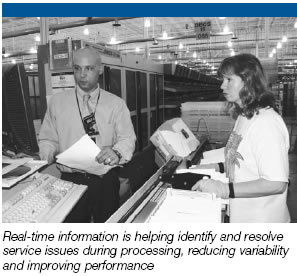Reduce Service Variability
This year service variability has improved greatly for single-piece First-Class Mail. The Postal Service‘s goals require continuous improvement to reduce service variability. The performance measurement systems, internal seeding of mail, other tracking systems like the 24-Hour Clock and Mail Pieces at Risk indicators, and Surface Visibility transportation data, will provide increasing amounts of detailed data about mail and operations. That data, matched against the network model developed for service standards, will enable more sophisticated, real-time analysis of service performance and a quicker response to resolve service issues, and reduce service variability. Additional tools such as value stream mapping and Lean Six Sigma will be used to improve the standard operating procedures, color coding policies, reporting systems, and other management tools necessary to support expanded service measurement.
Submit Plan to Meet New Goals

The Postal Service must submit to Congress by June 2008 a plan for rationalizing and implementing changes to its infrastructure and workforce to meet the new service standards. The plan will include performance goals and describe any changes to Postal Service processing, transportation, delivery, and retail networks necessary to meet the performance goals. Service performance goals will reflect product features, a balance of customer needs for timely delivery, and the capabilities of the postal network with a focus on reliable and consistent service. Many partners in the value chain affect service. Therefore, the plan will also identify needed improvement in mail design, production, and transportation before mail even arrives at a postal facility.
To meet the requirements for annual compliance reporting, the Postal Service will provide service data currently available for single-piece First-Class Mail, as well as for retail Package Services in the Annual Compliance Report. In 2009, new service measurement systems will be operational with scores reported quarterly.
Adjust Shipping Services Performance to Meet Market Requirements
The Postal Service plans to develop market-based benchmarks for shipping services products. Those benchmarks will be used to adjust service offerings and pricing strategies to meet customer expectations and the needs of the marketplace. For some products, opportunities exist to change current operations and transportation. Other adjustments will include bundling features and services to improve customer convenience and reduce transaction and other costs. Performance data gathered from shipping services will enable further improvements in service, mail quality, and operational efficiency. It will also enable the ability to provide track and trace information. New features will enhance the value of shipping services and allow customers to continue to make informed choices.
3. Cut Undeliverable-as-Addressed Mail Costs in Half
Estimates of the amount of mail that is undeliverable-as-addressed (UAA) are in the billions of pieces, resulting in well over $1 billion in postal costs each year and enormous waste and unnecessary expense for mailers. Addresses that are incomplete or out of date affect service as well as costs. Even when incorrectly addressed mail can be delivered, it is commonly delayed and re-routed multiple times.
The Postal Service‘s goal is to cut the 2004 cost of UAA mail in half by 2010. To achieve this goal, it is working with mailers to validate address information and improve the quality, accuracy, and timeliness of address lists. Best practices for maintaining correct addresses include using both pre-mailing tools like the National Change of Address (NCOA) software and post-mailing tools like the Address Change Service (ACS) software to verify move updates. As a result, customers are running and matching more address records and mail address quality is improving. In 2006, a real time electronic service was introduced that enabled mailers to update their address databases more frequently.
Intelligent Mail provides an electronic link that drives down the cost of the ACS processing. Convenience and lower costs are increasing use of ACS to update addresses. OneCode ACS for First-Class Mail and Periodicals allows mailers to update addresses for customers who have moved. OneCode ACS for Standard Mail was made available in October 2007.

